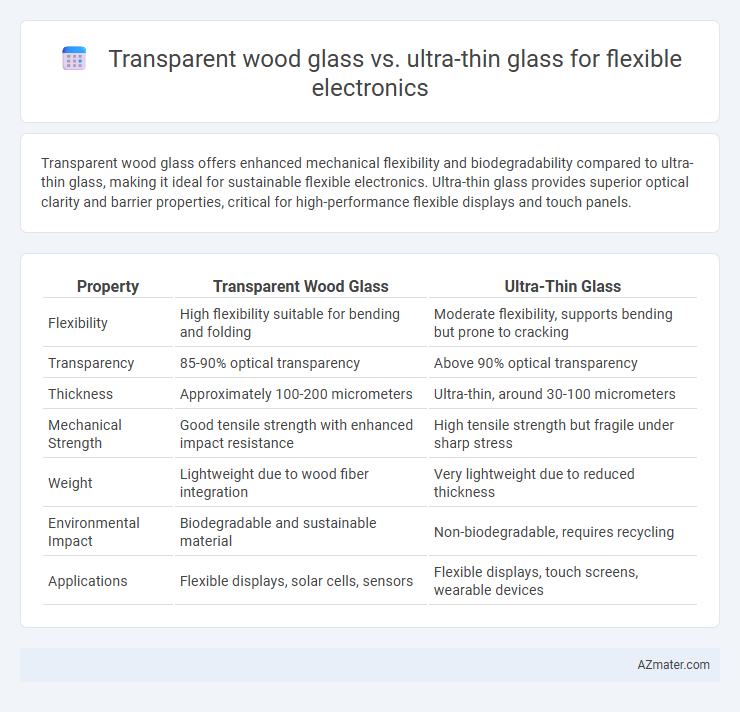Transparent wood glass offers enhanced mechanical flexibility and biodegradability compared to ultra-thin glass, making it ideal for sustainable flexible electronics. Ultra-thin glass provides superior optical clarity and barrier properties, critical for high-performance flexible displays and touch panels.
Table of Comparison
| Property | Transparent Wood Glass | Ultra-Thin Glass |
|---|---|---|
| Flexibility | High flexibility suitable for bending and folding | Moderate flexibility, supports bending but prone to cracking |
| Transparency | 85-90% optical transparency | Above 90% optical transparency |
| Thickness | Approximately 100-200 micrometers | Ultra-thin, around 30-100 micrometers |
| Mechanical Strength | Good tensile strength with enhanced impact resistance | High tensile strength but fragile under sharp stress |
| Weight | Lightweight due to wood fiber integration | Very lightweight due to reduced thickness |
| Environmental Impact | Biodegradable and sustainable material | Non-biodegradable, requires recycling |
| Applications | Flexible displays, solar cells, sensors | Flexible displays, touch screens, wearable devices |
Introduction to Emerging Transparent Materials
Transparent wood and ultra-thin glass represent cutting-edge materials revolutionizing flexible electronics due to their unique optical clarity and mechanical flexibility. Transparent wood combines natural cellulose nanofibers with polymers to achieve high strength, low density, and impressive light transmission, making it a sustainable alternative to conventional glass. Ultra-thin glass, typically less than 100 microns thick, offers exceptional transparency, chemical resistance, and bending capability essential for foldable displays and wearable devices.
Overview of Transparent Wood Glass
Transparent wood glass is an innovative material combining natural wood's mechanical strength with glass-like transparency, making it ideal for flexible electronics applications. It features a laminated structure that enhances flexibility while maintaining high optical clarity and durability, outperforming traditional borosilicate glasses in impact resistance. This material supports sustainable manufacturing with lower environmental impact compared to ultra-thin glass, offering promising scalability for next-generation flexible displays and sensors.
Ultra-Thin Glass: Properties and Applications
Ultra-thin glass (UTG) offers exceptional mechanical flexibility, high optical clarity, and superior barrier properties against moisture and oxygen, making it ideal for flexible electronics such as foldable smartphones, wearable devices, and flexible displays. Compared to transparent wood glass, UTG provides a much smoother surface finish and greater dimensional stability under bending stress, which enhances device durability and performance. Its ultrathin profile, often less than 100 microns, supports seamless integration into advanced electronic components requiring lightweight, transparent, and robust protective layers.
Optical Transparency and Light Transmission
Transparent wood glass exhibits high optical transparency with light transmission rates exceeding 85%, making it suitable for flexible electronics requiring clear display clarity and effective light passage. Ultra-thin glass offers superior optical transparency with transmittance often surpassing 90%, coupled with excellent mechanical flexibility and scratch resistance vital for high-performance flexible devices. Both materials are engineered to maximize light transmission while maintaining flexibility, but ultra-thin glass typically outperforms transparent wood glass in optical purity and consistent light diffusion.
Flexibility and Mechanical Strength Comparison
Transparent wood glass offers superior flexibility due to its cellulose nanofiber structure, enabling it to bend without cracking under repeated stress. Ultra-thin glass provides high mechanical strength and excellent scratch resistance but tends to be more brittle, limiting its bending radius in flexible electronics applications. For devices requiring extensive bending and durability, transparent wood glass often outperforms ultra-thin glass in maintaining performance and structural integrity.
Fabrication and Scalability of Both Materials
Transparent wood glass offers a unique fabrication advantage through a bio-based process involving lignin removal and polymer impregnation, enabling lightweight, flexible substrates with eco-friendly scalability. Ultra-thin glass fabrication relies on advanced float glass technology combined with precise thermal and chemical treatments to achieve nanoscale thickness, supporting high-throughput roll-to-roll processing for large-scale electronics manufacturing. Scalability of transparent wood glass faces challenges in uniform thickness control and mechanical robustness, whereas ultra-thin glass benefits from well-established industrial infrastructure, ensuring consistent quality and mass production efficiency for flexible electronic applications.
Environmental Impact and Sustainability
Transparent wood glass offers superior environmental benefits compared to ultra-thin glass, as it is derived from renewable biomass and features lower energy consumption during production. Ultra-thin glass, while recyclable, relies on energy-intensive manufacturing processes and non-renewable raw materials, leading to higher carbon emissions. Sustainable flexible electronics increasingly favor transparent wood glass for its biodegradability and reduced ecological footprint in end-of-life disposal.
Performance in Flexible Electronics
Transparent wood glass offers high tensile strength and excellent flexibility, making it suitable for bendable displays and wearable devices, whereas ultra-thin glass provides superior optical clarity and scratch resistance but with relatively lower elasticity. In flexible electronics, transparent wood glass enhances durability under repeated mechanical stress, improving device longevity and performance in dynamic environments. Ultra-thin glass remains ideal for applications requiring sharp image quality and surface hardness, balancing flexibility with protection in foldable smartphones and flexible sensors.
Cost Analysis and Commercial Viability
Transparent wood glass offers lower material costs and easier scalability compared to ultra-thin glass in flexible electronics, primarily due to its renewable biomass origin and simpler manufacturing processes. Ultra-thin glass, while providing superior barrier properties and mechanical strength, incurs higher production expenses linked to energy-intensive fabrication and fragile handling requirements. The commercial viability of transparent wood glass improves with ongoing advancements in durability and uniformity, positioning it as a cost-effective substitute in flexible display and wearable device markets where budget constraints are critical.
Future Trends and Market Outlook
Transparent wood glass offers superior flexibility, sustainability, and impact resistance, making it a promising material for next-generation flexible electronics, particularly in wearable and foldable devices. Ultra-thin glass dominates current flexible electronics due to its excellent chemical stability, high transparency, and durability, with significant growth driven by consumer demand for premium touchscreens and displays. Market forecasts project an expanding hybrid approach leveraging the strengths of both materials, fueling innovation and increasing adoption in flexible and rollable electronic applications globally.

Infographic: Transparent wood glass vs Ultra-thin glass for Flexible electronics
 azmater.com
azmater.com